What is Ewdf virus?
Ewdf virus is a new ransomware that attacks the victim’s computer by encrypting files and demanding a ransom for decrypting them. The ransomware attack can lead to data loss and financial losses. Ewdf encrypts files, renames them by appending the .ewdf extension, and creates files named “_readme.txt” containing the ransom demand message. For example, a file named “document.docx” will be renamed to “document.docx.ewdf”, a “image.jpg” file to “image.jpg.ewdf”, “invoice.pdf” to “invoice.pdf.ewdf”, and so on.
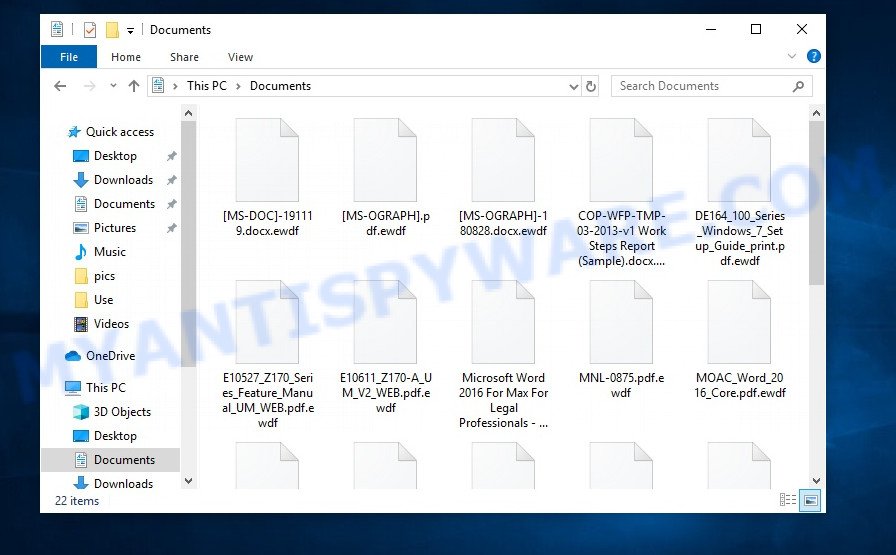
Screenshot of files encrypted by Ewdf virus (‘.ewdf’ file extension)
QUICK LINKS
- What is Ewdf virus?
- Remove Ewdf virus (ransomware)
- Decrypt .ewdf files
- Restore .ewdf files
- Video Guide
Ewdf ransomware is a malicious program created to encrypt files on a victim’s computer. This malware is the 490th version of the STOP (Djvu) ransomware. Almost always, this malware penetrates the computer undetected when the user runs files downloaded from unsafe websites. The most common source of infection are cracked games, Windows and Microsoft Office activators, and other similar software.
Upon execution, Ewdf copies itself to the Windows system directory, changes some OS settings and collects information about the infected computer. Then the malware tries to establish a connection with its control server. If the connection was established, the Ewdf ransomware sends information about the infected computer to the server. The server processes the received information, and then sends the key, which must be used to encrypt files. Such an encryption key is called an online key and this key is unique for every ransomware infection. If the malware was unable to establish a connection with its server, then it uses a fixed key, and this key is the same for all infected computers (so-called ‘offline key’).

The key type is very important because at the moment only files encrypted with the offline key can be decrypted, and only after the key has been obtained by security researchers. Security researchers have already obtained many offline keys for various variants of the STOP (Djvu) ransomware.
A file with the extension “ewdf” is a file encrypted by the Ewdf ransomware. This means that the file is locked, its contents cannot be accessed in any way. If you rename the file, delete its extension, it will not be able to unlock its contents, it will remain encrypted. This is because the malware uses an encryption algorithm with a long key, so it is impossible to find out this key or determine it using an encrypted and unencrypted file. This ransomware encrypts all files located on the computer, which means that files located on local disks and files on connected network storage will be encrypted. Each encrypted file gets a new name, which consists of its old and the “.ewdf” extension appended to the right. There is a small exception, the malware does not encrypt files with the name “_readme.txt”, files located in the Windows system directories, as well as files that have the “.dll, .lnk, .bat, ini, .sys” extension. Thus, the following types of files can be encrypted:
.p7c, .vtf, .mdb, .ppt, .ntl, .csv, .itl, .mpqge, .erf, .sum, .1st, .sie, .itm, .xmmap, .pem, wallet, .qic, .3fr, .vdf, .re4, .rwl, .xpm, .7z, .mef, .y, .xxx, .fpk, .vcf, .zdc, .rim, .mp4, .xlsb, .wot, .m2, .hkx, .sb, .wpd, .xlk, .wb2, .odp, .png, .rofl, .txt, .icxs, .vpp_pc, .docx, .jpg, .map, .pptx, .bay, .cfr, .wpa, .wgz, .jpe, .wp4, .dazip, .dcr, .xdb, .py, .hkdb, .wpw, .vpk, .pef, .xx, .x3f, .wpg, .xll, .1, .p12, .wotreplay, .bar, .epk, .pfx, .odc, .hplg, .wdp, .xyp, .z3d, .srf, .gdb, .sis, .bsa, .wma, .blob, .w3x, .mov, .zif, .eps, .ws, .wpl, .d3dbsp, .xlgc, .zabw, .qdf, .desc, .ybk, .cer, .xld, .psk, .webdoc, .zdb, .esm, .mdbackup, .das, .accdb, .pptm, .jpeg, .odm, .kf, .xyw, .rtf, .crw, .bc6, .iwi, .wma, .mddata, .xbdoc, .wcf, .3dm, .r3d, .big, .wp7, .wps, .dbf, .raw, .mcmeta, .bkf, .m3u, .xmind, .lvl, .raf, .docm, .dng, .mrwref, .pkpass, .wpe, .xwp, .ff, .forge, .pdf, .orf, .wri, .hvpl, .rw2, .dmp, .bc7, .wsc, .srw, .wsd, .gho, .rb, .dba, .nrw, .itdb, .psd, .doc, .slm, .xls, .wbc, .t12, .lbf, .zip, .ztmp, .upk, .apk, .ltx, .cr2, .kdb, .wp5, .wbz, .wps, .sr2, .asset, .pak, .rar, .ai, .x3d, .odt, .z, .xlsx, .xar, .zi, .ncf, .webp, .ibank, .db0, .iwd, .js, .xlsm, .fos, .wbmp, .m4a, .layout, .wire, .xlsx, .xml, .indd, .fsh, .wmf, .mdf, .ods, .yml, .bkp, .mlx, .bik, .p7b, .cas, .sid, .wmv, .sidn, .sql, .xdl, .tor, .wbm, .wp, .crt, .t13, .x, .wn, .rgss3a, .arch00, .dwg, .xbplate, .wmd, .sidd, .wbk, .svg, .0, .dxg, .der, .cdr, .2bp, .kdc, .pst, .tax, .zip, .ysp, .ptx, .wpd, .x3f, .litemod, .xy3, .flv, .zw, .wav, .wmv, .menu, .wsh, .yal, .css, .wpt, .avi, .wm, .wdb, .snx, .wmo, .pdd, .xf, .arw, .wpb, .vfs0, .xlsm, .odb
In directories where there are encrypted files, the Ewdf ransomware drops files called “_readme.txt”. These files contain a message from the Ewdf authors. The content of all files with this name is the same and does not depend on which directory the file is in.
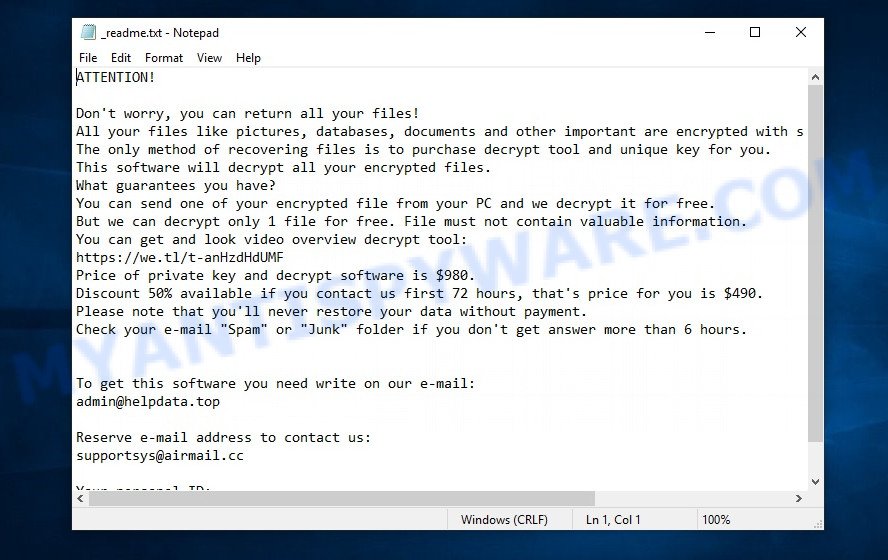
Screenshot of the contents of ‘_readme.txt’ file (ransom demand message)
This file is a ransom demand message. Almost any ransomware leaves a similar message on the infected computer. In this message, the criminals report that the files on the computer are encrypted and demand a ransom in exchange for the key and the decryptor. The Ewdf authors demand $980 for a key and a decryptor pair, but at the same time they promise to reduce the ransom by half if the ransom is paid within 72 hours. To demonstrate to the owner of an infected computer that encrypted files can be decrypted, attackers offer the victim to send one encrypted file to the address specified in the ransom request. Attackers promise to decrypt this file for free.
The full text of the ransomnote is:
ATTENTION!
Don’t worry, you can return all your files!
All your files like pictures, databases, documents and other important are encrypted with strongest encryption and unique key.
The only method of recovering files is to purchase decrypt tool and unique key for you.
This software will decrypt all your encrypted files.
What guarantees you have?
You can send one of your encrypted file from your PC and we decrypt it for free.
But we can decrypt only 1 file for free. File must not contain valuable information.
You can get and look video overview decrypt tool:
https://we.tl/t-anHzdHdUMF
Price of private key and decrypt software is $980.
Discount 50% available if you contact us first 72 hours, that’s price for you is $490.
Please note that you’ll never restore your data without payment.
Check your e-mail “Spam” or “Junk” folder if you don’t get answer more than 6 hours.To get this software you need write on our e-mail:
admin@helpdata.topReserve e-mail address to contact us:
supportsys@airmail.ccYour personal ID:
0490xxxxxxxx
Threat Summary
| Name | Ewdf ransomware, Ewdf file virus |
| Type | Filecoder, Crypto malware, File locker, Ransomware, Crypto virus |
| File extension | .ewdf |
| Ransom note | _readme.txt |
| Contact | admin@helpdata.top, supportsys@airmail.cc |
| Ransom amount | $490 or $980 in Bitcoins |
| Detection Names | CoinMiner/Win.Glupteba, Win32:CrypterX-gen [Trj], HEUR/AGEN, Win/malicious_confidence_100% (W), W32/Kryptik.FXB.gen!Eldorado, Trojan.Win32.Azorult, W32.AIDetect.malware2, Trojan.Crypt (A), HEUR:Trojan-Ransom.Win32.Stop.gen, ML/PE-A + Troj/Krypt-BO, Trojan.Win32.Agent |
| Symptoms | Unable to open personal files. You get an error message like ‘Windows can’t open this file’, ‘How do you want to open this file’. Files named such as ”, ‘READ-ME’, ‘_open me’, _DECRYPT YOUR FILES’ or ‘_Your files have been encrypted” in every folder with an encrypted file. ‘All files on your computer have been encrypted’ message on your desktop. |
| Distribution ways | Spam mails that contain malicious links. Malicious downloads that happen without a user’s knowledge when they visit a compromised web page. Social media posts (they can be used to trick users to download malware with a built-in ransomware downloader or click a misleading link). Malicious websites. |
| Removal | Ewdf ransomware removal guide |
| Decryption | Ewdf File Decrypt Tool |
| Recovery | Ewdf File Recovery Tools |
According to the security researchers, the Ewdf ransomware uses a strong encryption algorithm and therefore it is impossible to decrypt .ewdf files without a key. Fortunately, there is a Ewdf File Decrypt Tool that can decrypt files, but only if the files are encrypted with an offline key and the key itself has already been found. Moreover, our team has developed several methods, each of which gives a chance to restore the contents of encrypted files. In order not to miss any important part of this manual, we recommend that you open it in your smartphone or bookmark this page.
How to remove Ewdf ransomware
Before you start decrypting or recovering .ewdf files, you need to remove Ewdf ransomware and its autostart entries. This must be done since otherwise the ransomware may re-encrypt the restored files. You can stop the ransomware from working, as it is not difficult to do. Another option is to perform a full system scan using free malware removal tools capable of detecting and removing ransomware infection.
It is very important to scan the computer for malware, as security researchers found that spyware could be installed on the infected computer along with the Ewdf ransomware. Spyware is a very dangerous security threat as it is designed to steal the user’s personal information such as passwords, logins, contact details, etc. If you have any difficulty removing the Ewdf virus, then let us know in the comments, we will try to help you.
To remove Ewdf ransomware, follow the steps below:
Kill Ewdf virus
Press CTRL, ALT, DEL keys together.

Click Task Manager. Select the “Processes” tab, look for something suspicious that is the Ewdf ransomware then right-click it and select “End Task” or “End Process” option. If your Task Manager does not open or the Windows reports “Task manager has been disabled by your administrator”, then follow the guide: How to Fix Task manager has been disabled by your administrator.
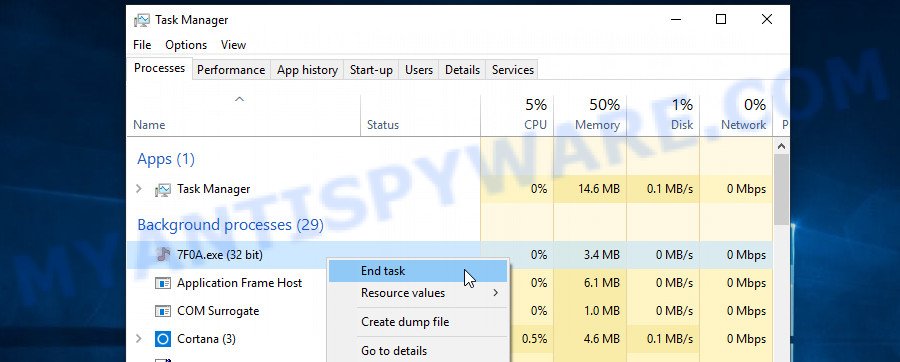
It is not difficult to detect a process related to the Ewdf ransomware. When looking for a malicious process, pay attention to the process icon and its name. Most often, this ransomware has a process name in the following format: 4-characters.tmp.exe or 4-characters.exe. For example: 7533.tmp.exe, A4b1.exe, CD15.tmp.exe, 19b2.exe. The process name can also contain “(32 bit)”. If you do not find a process with a similar name in the list of processes, then most likely the Ewdf ransomware has finished working. But keep in mind, if you do not remove the ransomware autostart entries, as demonstrated below, and do not delete its file, then after a while it may start again, and if it finds unencrypted files, immediately encrypt them.
Disable Ewdf Start-Up
Select the “Start-Up” tab, look for something similar to the one shown in the example below, right click to it and select Disable.

Close Task Manager.
Delete the Ewdf ransomware Task
Type “Task Scheduler” in the search bar. Click Task Scheduler app in the search results. Click “Task Scheduler Library” in the left panel. On the right panel, right-click to “Time Trigger Task” and select Delete.
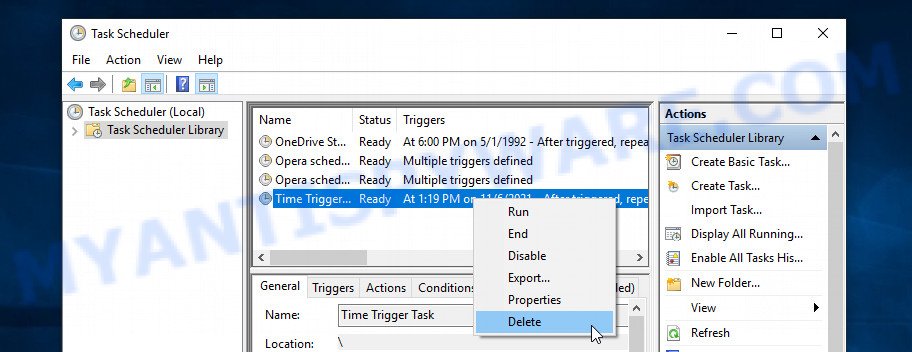
Close Task Scheduler.
Remove Ewdf virus
Run Task Manager and select the “Start-Up” tab. Right click to the Ewdf ransomware Start-Up entry and select Open File Location as shown below.

A directory containing one file will open in front of you, this file is the Ewdf virus. It needs to be removed. If you try to delete it immediately, then you will not succeed, since this file is protected from deletion.
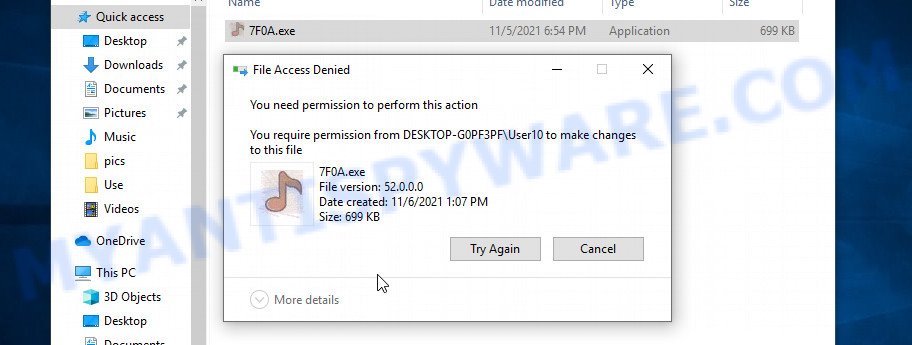
To delete this file, you need to do the following. Right-click on the file, select Properties. In the window that opens, select Security tab. Next, click the Advanced button below. A window will open as shown in the following example.
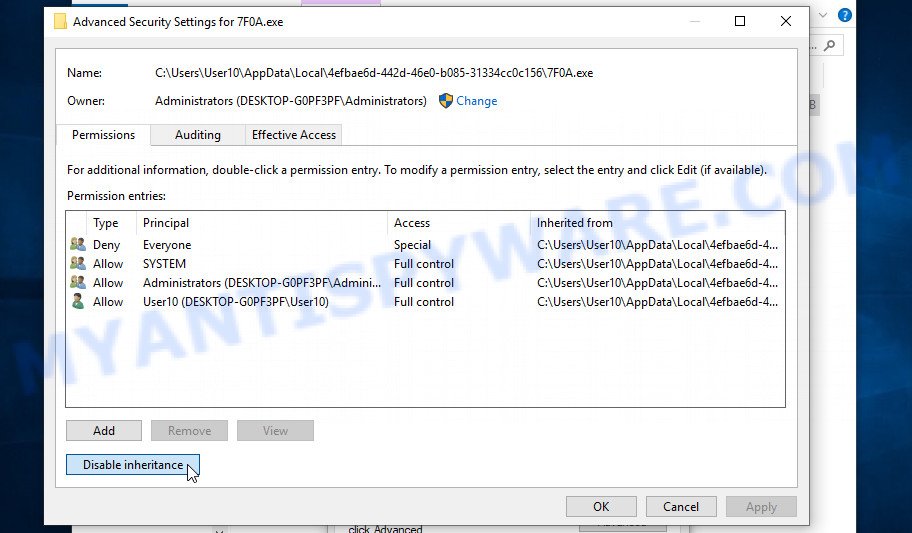
Click Disable inheritance. In the Block inheritance dialog box that opens, select the first item (Convert inherited permissions…) as shown below.

In the Permission entries list, select “Deny Everyone”, click Remove button and then OK. Close the file properties window. You should now be able to remove Ewdf virus. Right-click on the file and select Delete.
Scan computer for malware
We advise using MalwareBytes AntiMalware. You can download and install MalwareBytes to detect and remove Ewdf ransomware from your computer. One of the biggest advantages of using MalwareBytes is that is easy to use and is free. Also, it constantly keeps updating its virus/malware signatures DB. Let’s see how to install and scan your computer in order to remove Ewdf from the system.
MalwareBytes can be downloaded from the following link. Save it on your Desktop.
327071 downloads
Author: Malwarebytes
Category: Security tools
Update: April 15, 2020
After the downloading process is complete, close all programs and windows on your PC. Double-click the install file named MBSetup. If the “User Account Control” dialog box pops up as displayed in the figure below, click the “Yes” button.
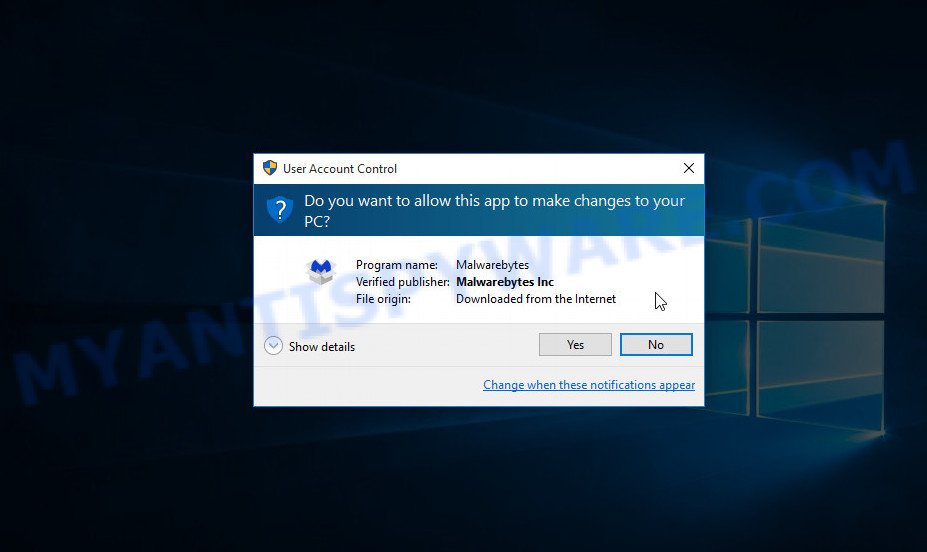
It will open the Setup wizard which will help you setup MalwareBytes on your personal computer. Follow the prompts and don’t make any changes to default settings.
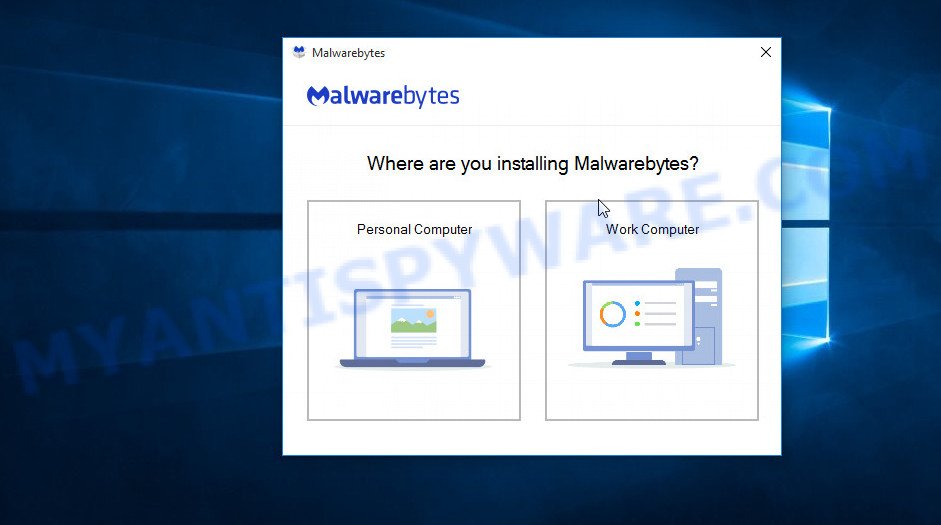
Once the install is done successfully, press “Get Started” button. MalwareBytes AntiMalware will automatically start and you can see its main screen as shown on the image below.
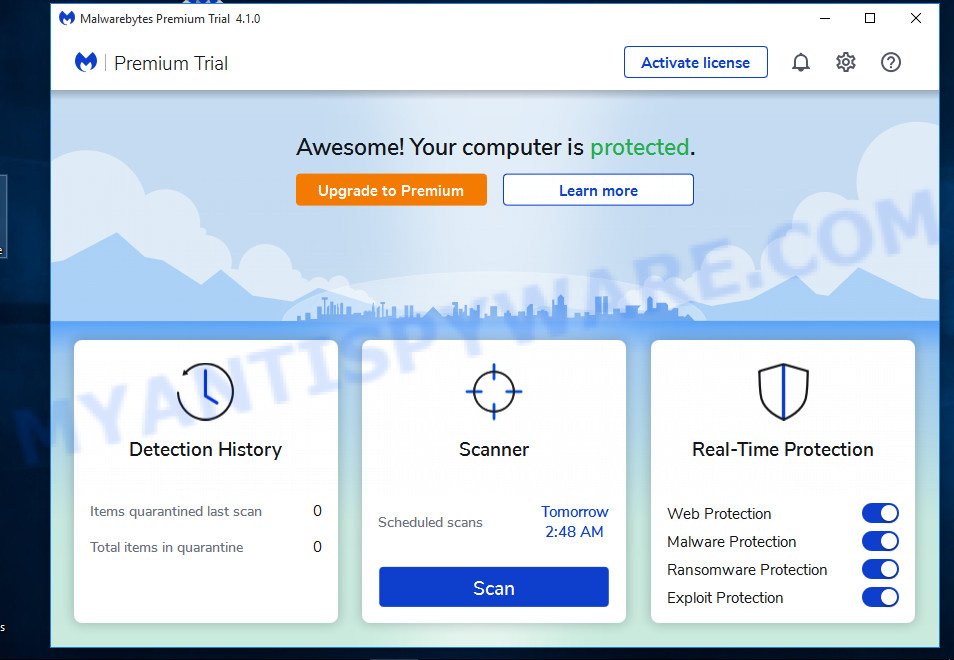
Now press the “Scan” button to scan your computer for ransomware, spyware, worms, trojans and other malicious software. During the scan MalwareBytes will locate security threats exist on your computer.
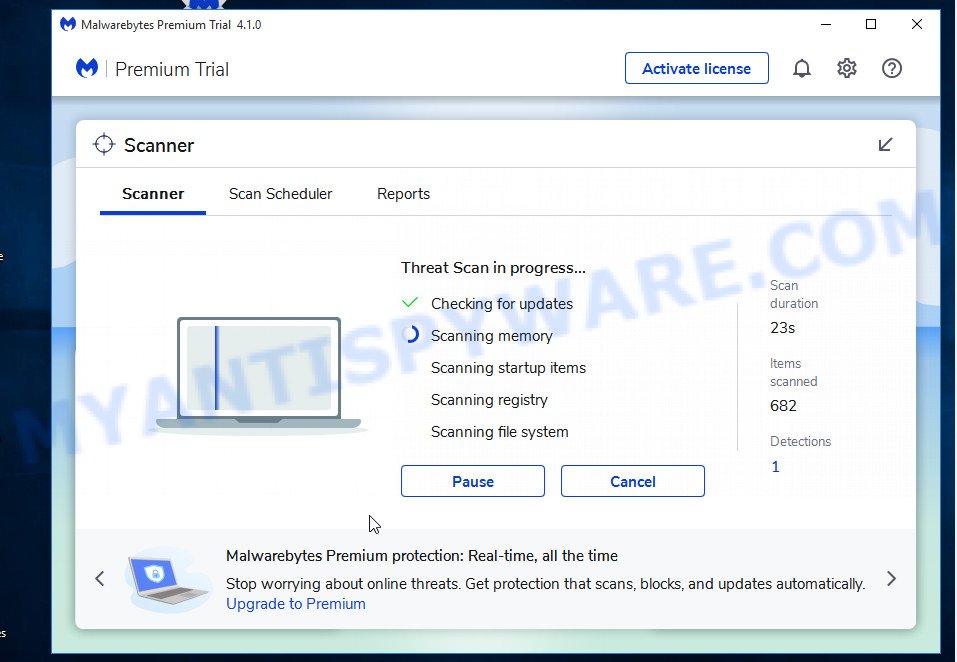
Once the scan is done, the results are displayed in the scan report. Review the scan results and then press “Quarantine” button. MalwareBytes will remove Ewdf related folders,files and registry keys and move the selected threats to the program’s quarantine. When finished, you may be prompted to restart the computer.

In order to be 100% sure that the computer no longer has the Ogdo malware, we recommend using the Kaspersky virus removal tool (KVRT). KVRT is a free portable program that scans your computer for spyware, ransomware, adware, PUPs, trojans, worms, malware and allows delete them easily. Moreover, it’ll also allow you remove any other security threats for free.
Download Kaspersky virus removal tool on your personal computer from the link below.
129235 downloads
Author: Kaspersky® lab
Category: Security tools
Update: March 5, 2018
Once the downloading process is done, double-click on the Kaspersky virus removal tool icon. Once initialization process is finished, you’ll see the KVRT screen as on the image below.

Click Change Parameters and set a check near all your drives. Click OK to close the Parameters window. Next click Start scan button to perform a system scan with this utility for the Ewdf ransomware virus and other known infections. When a threat is detected, the number of the security threats will change accordingly.

Once Kaspersky virus removal tool has completed scanning, Kaspersky virus removal tool will create a list of malicious software and ransomware like below.

Review the results once the utility has complete the system scan. If you think an entry should not be quarantined, then uncheck it. Otherwise, simply press on Continue to start a cleaning task.
How to decrypt .ewdf files
All files with .ewdf extension are encrypted and the only way to access their contents is to decrypt them. To decrypt .ewdf files, you need to use a unique key and decryptor. As we said above, Emsisoft company was able to create a decryptor and found a way in some cases to determine the key that was used to encrypt the files. This helps ransomware victims to decrypt .ewdf files for free.

Ewdf File Decrypt Tool (STOP Djvu decryptor)
To decrypt .ewdf files, use Ewdf File Decrypt Tool
- Download Ewdf File Decrypt Tool from the following link.
STOP Djvu decryptor - Scroll down to ‘New Djvu ransomware’ section.
- Click the download link and save the decrypt_STOPDjvu.exe file to your desktop.
- Run decrypt_STOPDjvu.exe, read the license terms and instructions.
- On the ‘Decryptor’ tab, using the ‘Add a folder’ button, add the directory or disk where the encrypted files are located.
- Click the ‘Decrypt’ button.
Ewdf File Decrypt Tool is a free tool that can decrypt files that were encrypted with an offline key, as Emsisoft found a way to find this key. Unfortunately, files encrypted with an online key cannot yet be decrypted. The online key is unique to each infected computer, and at the moment there is no way to find this key. Of course, criminals have this key, but we do not think that paying a ransom is a way to decrypt .ewdf files. In the case when the files are encrypted with an online key, there is a chance to restore the encrypted files using alternative methods, which are described below.
How to find out which key was used to encrypt files
Below we show two ways to help you determine what type of key was used to encrypt the files. This is very important, since the type of key determines whether it is possible to decrypt .ewdf files for free. We recommend using the second method, as it is more accurate.
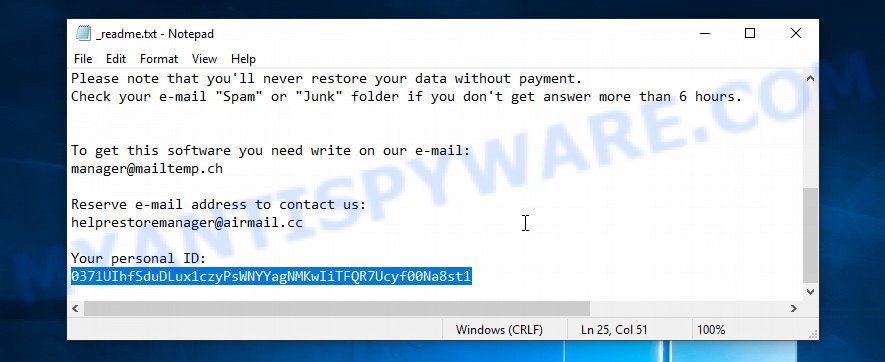
Personal ID is highlighted here
Find out the type of key using ‘_readme.txt’ file
- Open the ransom demand message (‘_readme.txt’ file).
- Scroll down to the end of the file.
- There you will see a line with the text ‘Your personal ID’.
- Below is a line of characters that starts with ‘0490’ – this is your personal id.
Find out the type of key using ‘PersonalID.txt’ file
- Open disk C.
- Open directory ‘SystemID’.
- Open file named ‘PersonalID.txt’. This file lists ‘Personal ID’s that match the keys that the virus used to encrypt files.
The ‘Personal ID’ is not a key, it is an identifier related to a key that was used to encrypt files. If the ID ends with ‘t1’, then the files are encrypted with an offline key. If the ID does not end with ‘t1’, Ewdf ransomware virus used an online key. If you could not figure out how to determine which key was used to encrypt files, then we can help. Just write a request here or in the comments below.
Ewdf File Decrypt Tool : “No key for New Variant online ID”
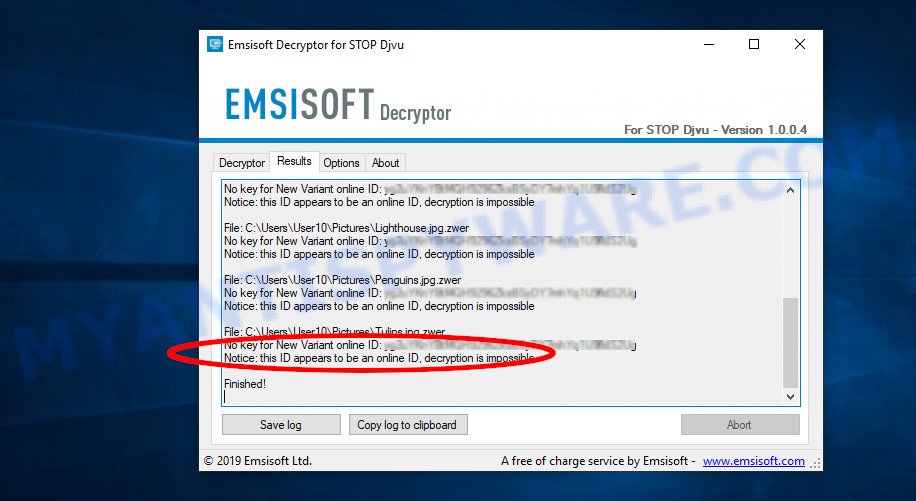
If, when you try to decrypt .ewdf files, Ewdf File Decrypt Tool reports:
No key for New Variant online ID: *
Notice: this ID appears to be an online ID, decryption is impossible
It means that your files are encrypted with an ‘online key’ and their decryption is impossible, since only the ewdf authors have the key necessary for decryption. In this case, you need to use alternative methods listed below to restore the contents of encrypted files.
Ewdf File Decrypt Tool : “No key for New Variant offline ID”
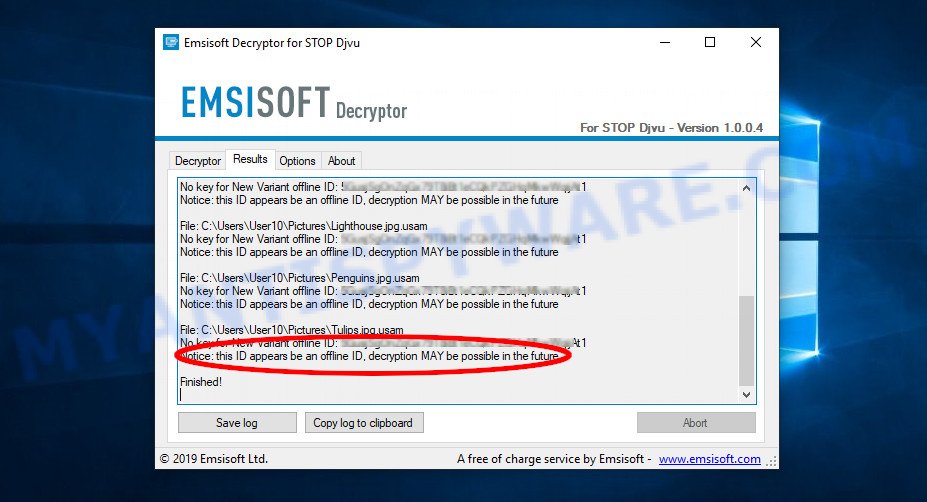
If, during decryption of .ewdf files, Ewdf File Decrypt Tool reports:
No key for New Variant offline ID: *t1
Notice: this ID appears be an offline ID, decryption MAY be possible in the future.
It means the following: your files are encrypted with an ‘offline key’, but the key itself has not yet been obtained by security researchers, in this case, you need to be patient and wait a while, in addition, you can also use alternative ways for recovering encrypted data.
If for some reason you were unable to decrypt the encrypted files, then We recommend to follow the news on our Facebook or YouTube channels. So you ‘ll know right away that it ‘s possible to decrypt .ewdf files.
This video step-by-step guide will demonstrate How to remove Ewdf virus, Decrypt/Recover .ewdf files.
How to restore .ewdf files
If your files are encrypted with .ewdf extension, then there is a chance that you can recover the files without decryption. We recommend using PhotoRec and ShadowExplorer that are designed to find and recover lost and deleted data. Mostly such programs are paid, but these tools can restore your files for free. Each of these tools has helped many times to recover files after ransomware infection in what would seem to be the most hopeless cases. We want to remind you that before you try to recover files, you need to scan your computer for ransomware using free malware removal tools. It is very important to find the Ewdf virus and completely remove it.
Use ShadowExplorer to recover .ewdf files
A free utility called ShadowExplorer is a simple way to use the ‘Previous Versions’ feature of Microsoft Windows 10 (8, 7 , Vista). You can restore photos, documents and music encrypted by the Ewdf ransomware from Shadow Copies for free.
Please go to the following link to download the latest version of ShadowExplorer for Microsoft Windows. Save it directly to your Windows Desktop.
439463 downloads
Author: ShadowExplorer.com
Category: Security tools
Update: September 15, 2019
When downloading is complete, extract the downloaded file to a directory on your computer. This will create the necessary files as shown on the screen below.

Run the ShadowExplorerPortable program. Now choose the date (2) that you want to recover from and the drive (1) you want to recover files (folders) from as shown on the screen below.

On right panel navigate to the file (folder) you want to restore. Right-click to the file or folder and click the Export button like the one below.

And finally, specify a folder (your Desktop) to save the shadow copy of encrypted file and click ‘OK’ button.
This video step-by-step guide will demonstrate How to recover encrypted files using Shadow Explorer.
Restore .ewdf files with PhotoRec
The last chance to restore encrypted files to their original state is using data recovery tools. We recommend a free tool called PhotoRec. It has all the necessary functions to restore the contents of encrypted files. It helped many victims recover data when it seemed like there was no more hope.
Download PhotoRec on your computer from the following link.
When downloading is finished, open a directory in which you saved it. Right click to testdisk-7.0.win and choose Extract all. Follow the prompts. Next please open the testdisk-7.0 folder as on the image below.

Double click on qphotorec_win to run PhotoRec for MS Windows. It’ll show a screen as shown on the image below.

Select a drive to recover like below.

You will see a list of available partitions. Choose a partition that holds encrypted files as displayed in the following example.

Click File Formats button and specify file types to restore. You can to enable or disable the recovery of certain file types. When this is complete, click OK button.

Next, press Browse button to select where restored personal files should be written, then press Search. We strongly recommend that you save the recovered files to an external drive.

Count of restored files is updated in real time. All restored files are written in a folder that you have chosen on the previous step. You can to access the files even if the restore process is not finished.
When the recovery is finished, click on Quit button. Next, open the directory where restored files are stored. You will see a contents as shown in the figure below.

All recovered photos, documents and music are written in recup_dir.1, recup_dir.2 … sub-directories. If you are searching for a specific file, then you can to sort your recovered files by extension and/or date/time.
This video step-by-step guide will demonstrate How to recover encrypted files using PhotoRec.
How to protect your PC from Ewdf ransomware
Most antivirus applications already have built-in protection system against the ransomware. Therefore, if your computer does not have an antivirus program, make sure you install it. As an extra protection, run the HitmanPro.Alert. All-in-all, HitmanPro.Alert is a fantastic tool to protect your PC from any ransomware. If ransomware is detected, then HitmanPro.Alert automatically neutralizes malware and restores the encrypted files. HitmanPro.Alert is compatible with all versions of MS Windows operating system from MS Windows XP to Windows 10.
Please go to the following link to download HitmanPro Alert. Save it on your Desktop.
Once the downloading process is finished, open the folder in which you saved it. You will see an icon like below.

Double click the HitmanPro Alert desktop icon. After the utility is started, you will be displayed a window where you can choose a level of protection, as shown on the screen below.

Now press the Install button to activate the protection.
To sum up
This guide was created to help all victims of the Ewdf ransomware virus. We tried to give answers to the following questions: how to remove ransomware; how to decrypt .ewdf files; how to recover encrypted files; what is an online key and what is an offline key. We hope that the information presented in this manual has helped you.
If you have questions, then write to us, leaving a comment below. If you need more help with Ewdf related issues, go to here.



















